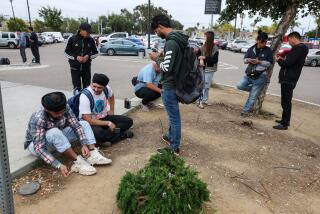Call Your Mother: A new campaign by...
- Share via
Call Your Mother: A new campaign by Pacific Bell urging customers to consider unblocking their phone numbers so the numbers can be made known to caller ID subscribers suggests the new service isn’t taking off as the phone company had hoped.
Caller ID, which debuted in California in July, allows people with a special device to see the phone numbers of those who are calling them, before they answer the phone. But callers also have the ability to prevent their numbers--either on a per-call or per-line basis--from being seen.
Pacific Bell and GTE won’t say how many of their customers have requested per-line blocking--the most restrictive form available--but Californians are so privacy-conscious that more than half have unlisted phone numbers. Both companies said sales of caller ID services have met expectations.
“I guess the phone company wants to sell more caller ID, and the only way to do that is if they have less blocking,” said Betsy Brandel, a consumer affairs supervisor with the California Public Utilities Commission in San Francisco. The PUC ordered the phone companies to conduct a massive education campaign explaining the privacy implications of caller ID and making customers aware of their right to block their phone numbers.
Indeed, if too many people block their numbers too much of the time, caller ID subscribers--who pay between $6.50 and $10 a month--may find little value in the service. Businesses represent a major market because they could use caller ID to capture the phone numbers of callers, then look up their names and addresses using a reverse directory and create databases of potential customers.
The Pacific Bell radio and newspaper ads that began running this month highlight another aspect of caller ID. They contend that callers who block their lines risk losing touch with family and friends who order the service and ignore anonymous incoming calls on the assumption they are from telemarketers. “Even your mother won’t know it’s you,” the ads read.
Joan Mataraci, Pacific Bell’s product manager for caller ID, said her company’s ads are a response to inquiries from confused customers with per-line blocking who were unable to complete some of their calls. Promoting the use of per-call blocking “certainly enhances the value” of caller ID, but that was not the motivation for the ads, she said.
Phone companies say the PUC-ordered education campaign might have scared consumers into ordering per-line blocking without a full understanding of how they might be affected.
“We always thought the public education campaign was bordering on the negative, with a negative slant toward caller ID,” GTE spokeswoman Carrie Hyun said.
PUC officials deny that, but some caller ID subscribers agree. Chuck Welch, a retired furniture distributor who lives in Hollywood, has ordered a service called “Block-the-Blocker,” which prevents calls from blocked lines from getting through to his phone. That has prompted much confusion among his friends who didn’t realize the potential inconveniences of ordering per-line blocking.
“Most of these people with blocking had no idea what they were getting,” Welch said. “They think it will prevent certain people from getting through to them, but they’ve got it completely reversed.”











